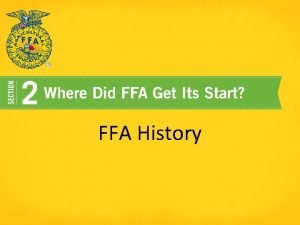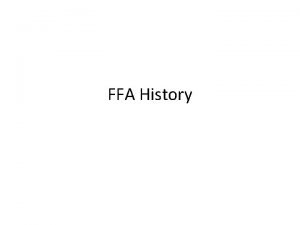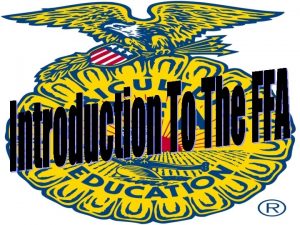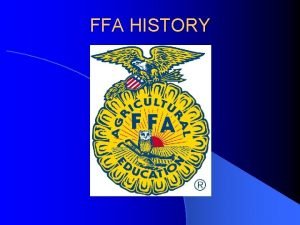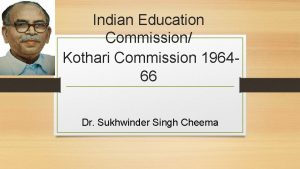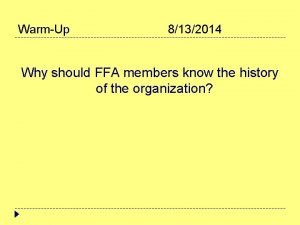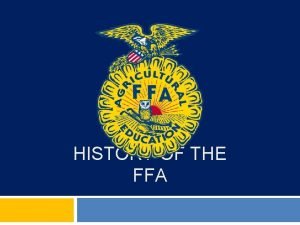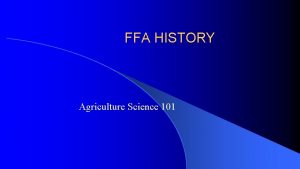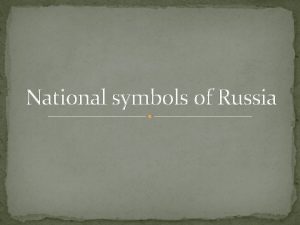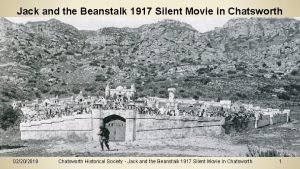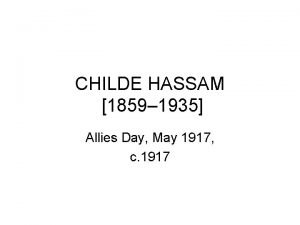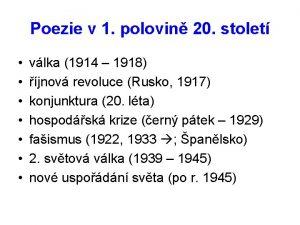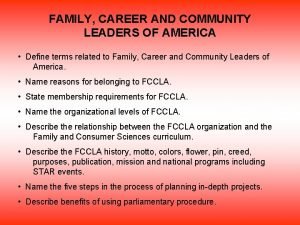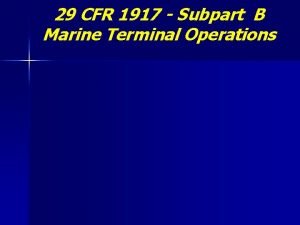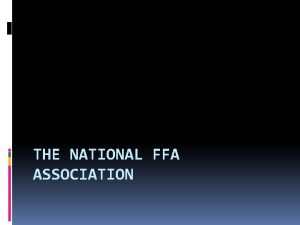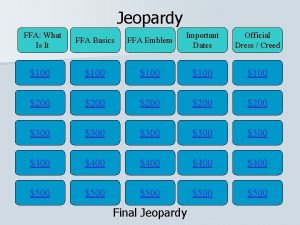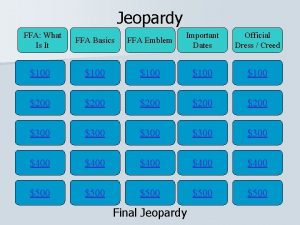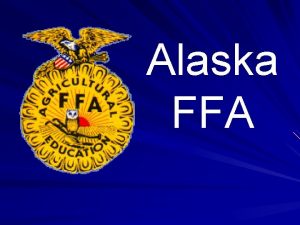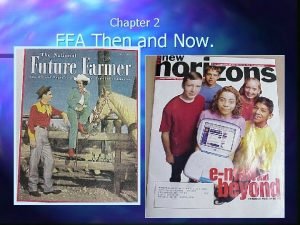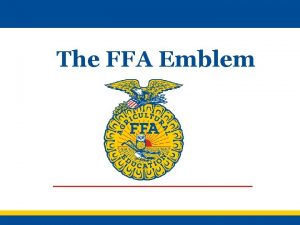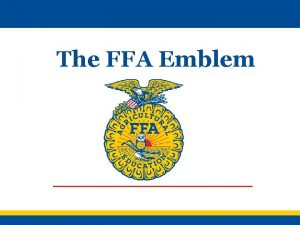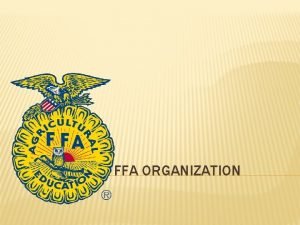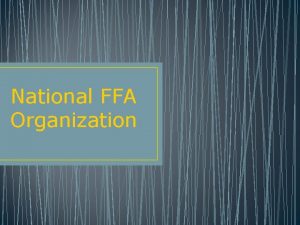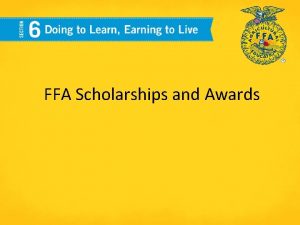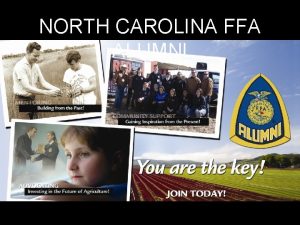FFA History 1917 National Vocational Education Act Created










































- Slides: 42


FFA History • 1917 National Vocational Education Act – Created vocational agriculture classes throughout the country. • 1928 the Future Farmers of America was established in Kansas City, Missouri at the American Royal

FFA Name • The National FFA Organization started as the Future Farmers of America. • This name was used for the first 60 years. • 1988 National FFA Convention Student leaders voted to change the official name to the National FFA Organization. • The current name respects the organizations roots while reflecting the science, business and technology of agriculture.

Federal Charter • The National FFA Organization in one of the few student organizations to have a federal charter (Public Law 105 -225). • This means that there is federal law that makes FFA an “intracurricular” part of the Agriculture Education program. • And allows it to be taught in the classroom.

Membership • When it was first created FFA was a organization for young men studying to become farmers. • In 1965 the NFA (New Farmers of America, for African American Students) combined with FFA. • In 1969 young ladies were allowed to join and active membership was open to all students enrolled in a agriculture education program.

Today’s FFA • The Mansfield FFA is only one of 7000 chapters across the nation. • With almost a half million members, FFA is the Nations largest student organization.

FFA Mission • FFA makes a positive difference in the lives of students by developing their potential for premier leadership, personal growth and career success through agriculture education.

Types of Membership • Active members are those members who are enrolled in an agriculture course and have paid their membership dues. • Collegiate members belong to FFA chapters at two or four year colleges and universities and are studying agriculture. • Alumni membership is open to anyone interested in supporting and promoting agriculture education. • Honorary membership is given to individuals who have provided outstanding service to FFA and agriculture education.

The FFA Emblem • The emblem is the logo of our organization. • It contains five separate simbols. • The cross section of the ear of corn serves as the emblems foundation. Corn is a symbol of unity because it is native to America and it is grown in every state.

The FFA Emblem • The Rising Sun appears in the center of the emblem and symbolizes progress in agriculture and confidence in the future.

The FFA Emblem • The plow is the symbol of labor and tillage of the soil.

The FFA Emblem • The Owl represents knowledge and wisdom.

The FFA Emblem • The Eagle perched on top of the emblem serves as a reminder of our freedom and the National scope of FFA

The FFA Emblem • The words agriculture education indicate that FFA is an important part of the agriculture education program.

FFA Colors • The FFA Jacket embodies the official FFA colors National Blue and Corn Gold.

The FFA Jacket • On the back of the jacket is printed your state association and your chapter. • On the front of the jacket is printed your name. • Each time you put on the FFA jacket you are representing not just the FFA but also your state, your chapter and your family name. • Make sure you always behave in such a manner that you will bring honor to our community, our state and your family!

Official Dress • Official dress for female members is a black skirt, white blouse with a official FFA scarf, black shoes, and the FFA jacket zipped to the top. Black slacks may be worn for traveling or outdoor activities.

Official Dress • Official dress for male members is black slacks, white shirt, official FFA tie, black shoes, and the FFA jacket zipped to the top.

Proper Use of the FFA Jacket • The jacket is only to be worn by members. • It should be kept clean and should be worn zipped up with the collar turned down. • All chapter degree, officer, and award metals should be worn beneath the name on the right side of the jacket. • The State FFA Degree and the American FFA degree metals are attached to a golden chain that attaches to the base of the jacket.

Proper Use of the FFA Jacket • No more than three metals should be worn on the jacket. • These should represent the highest degree earned, the highest office held and the highest award earned by the member.

FFA Motto

FFA Salute • The Pledge of Allegiance is the official salute of the National FFA Organization. • It is part or each meetings closing ceremonies.

Healthy Lifestyles • FFA members are encouraged to make healthy choices in the way they live their lives. • This means among other things that they live free from alcohol and drugs, including tobacco. • Drug and alcohol use can have lasting negative impact on your body and mind, including damage to the liver, kidneys and vital organs, and even death. • Drug and alcohol use can also severely damage relationships with friends and family in ways that are difficult or impossible to repair.

Healthy Lifestyles • People under the influence of alcohol are responsible for more than 50, 000 fatal auto accidents each year, as well as a wide range of other accidents, suicides and crimes. • Alcohol and drug abuse often leads to involvement in other dangerous behaviors that can lead to HIV / AIDS and other sexually transmitted diseases and unwanted pregnancies.

FFA Code of Ethics • FFA encourages members to make choices that improve there chances for a long, healthy life that is meaningful and productive. • Respect the rights of others and their property. • Be courteous, honest and fair with others. • Demonstrate good sportsmanship by being modest in winning and generous in defeat. • Appreciate and promote diversity in our organization.

Essentials of a Successful Chapter • 1. Knowledge of FFA its programs and opportunities. • 2. Membership Diversity: Successful chapters do all they can to encourage a variety of students enroll in agriculture education and join FFA. A diverse membership fosters broader thinking and ideas. • 3. All Members Share Responsibility: Each member not just the officers should take and active part in the success of a chapter. Each member is assigned to a committee that has specific responsibilities.

Essentials of a Successful Chapter • 4. A capable officer team. Officers must have the talent and dedication necessary to lead the chapter. Officers serve as role models for other students. • 5. Challenging Program of Activities. Successful chapters are active in the community and provide a good diversity of wholesome activities that are educational and fun.

Essentials of a Successful Chapter • 6. Workable Constitution and Bylaws. The constitution outlines the rules and procedures for the local chapter. If provides structure and guidelines for members to follow. • 7. Proper Equipment and Records: Complete financial and membership records as well as minutes of each of the meetings are an important element of a successful chapter.

Essentials of a Successful Chapter • 8. Well planned, regularly held chapter meetings. Monthly meetings should be scheduled at a regular time. They should have a clear agenda. The president should preside according to correct parliamentary procedure so the meetings are run efficiently and all members are encourage to be evolved. The meetings should start and end with the traditional FFA opening and closing ceremonies.

Essentials of a Successful Chapter • 9. Adequate Financing: Fundraising projects are essential in FFA. Yearling earnings fund important activities, meetings and projects. • 10. School and Community Support. A successful chapter strives to meet community needs. Many chapter activities depend on local support. Public relation activities that inform the community are important.

Program of Activities • Is more than just a calendar with the dates of the activities for the year. • It serves as a roadmap for the chapter. Activities should revolve around three divisions: – Student Development – Chapter Development – Community Development

Program of Activities • Each member is assigned or volunteers for a specific committee. • Each committee works on different areas of the POA. • Committee work gets more members involved and planning is easier when done in a small group rather than a large one. • Committees are often chaired by chapter officers with related duties. • The public relations committee is chaired by the chapter reporter, the finance committee is chaired by the treasurer.

Chapter Leadership • FFA is an organization of, by and for students. • The local chapter is lead by a team of chapter officers also known as the executive committee. • The chapter advisor plays a ex-officio, nonvoting, advisory role. • These students organize chapter activities and lead by example. • Most chapters elect a president, Vice president, Secretary, Treasurer, Reporter and Sentinel. • You may also elect an historian, parliamentarian, a chaplain or other officers as needed.

Chapter Leadership • Local officers should encourage fellow members to participate and get involved. • Each officer should have … – A genuine desire to be part of a leadership team and to accept responsibility. – A commitment to lead by example. – A knowledge and understanding of FFA and parliamentary procedure. – A ability to memorize and recite their parts in opening ceremonies.

Chapter Leadership • The President: Presides over meetings according to rules of parliamentary procedure. Prepares the agenda for each meeting.

Chapter Leadership • The Vice-President: Fills in for the president if needed. Develops the POA, and Fills out the National Chapter Award Application, and maintains chapter activity records along with the secretary.

Chapter Leadership • The Secretary: Prepares and presents the minutes of each meeting. Is responsible for all chapter correspondence (Thank you cards and Invitations).

Chapter Leadership • The Treasurer: Receives, records and deposits FFA funds and issues receipts. Presents a monthly treasurers report at each chapter meeting. Serves as chairman of the finance committee and organizes chapter fundraisers. Maintains the chapter travel account.

Chapter Leadership • The Reporter: Release news and information to local news media. Publish chapter news letter. Serve as chapter photographer.

Chapter Leadership • Sentinel: Assist the president in maintaining order. Help prepare and take down the meeting room. Welcome guests and visitors. Help usher candidates who are receiving degrees or awards. Assist with special features and refreshments.

Chapter Leadership • Historian: Develops and maintains the chapter scrap book. Prepares displays of the chapters activities. Assists the reporter in providing photography for chapter needs.

Opening Ceremonies • Turn to Page 45 of your FFA Handbook and go through FFA Opening Ceremonies.
 Ffa 1969
Ffa 1969 What act was passed in 1917 ffa
What act was passed in 1917 ffa 1917 ffa history
1917 ffa history Industrialization definition ap world history
Industrialization definition ap world history Selective service act of 1917
Selective service act of 1917 The espionage act of 1917
The espionage act of 1917 Smith hughes act ffa
Smith hughes act ffa Ffa facts and history
Ffa facts and history 1917 succession act
1917 succession act Strengthened technical vocational education program
Strengthened technical vocational education program Criticisms of new vocationalism
Criticisms of new vocationalism Education commission 1964
Education commission 1964 Aims of secondary education
Aims of secondary education Vocational education in russia
Vocational education in russia Vocational education uae
Vocational education uae Vocational in a sentence
Vocational in a sentence Criticisms of vocational education
Criticisms of vocational education 451 fahrenheit in celsius
451 fahrenheit in celsius Macbeth act 3-5 summary
Macbeth act 3-5 summary National ffa alumni association was formed
National ffa alumni association was formed History of the ffa emblem
History of the ffa emblem What was the name of the first ffa magazine
What was the name of the first ffa magazine What is the official salute of the ffa organization
What is the official salute of the ffa organization Stbl. 1917 no. 130 jo. 1919 no. 81
Stbl. 1917 no. 130 jo. 1919 no. 81 March 1917 revolution
March 1917 revolution Chapter 27 the crisis of the imperial order
Chapter 27 the crisis of the imperial order Russian national symbols
Russian national symbols Marcel duchamps
Marcel duchamps Jack and the beanstalk 1917
Jack and the beanstalk 1917 Childe hassam allies day may 1917
Childe hassam allies day may 1917 Becoming a world power 1865-1917
Becoming a world power 1865-1917 Brejmyslivec
Brejmyslivec Anime 1917
Anime 1917 Becoming a world power 1872-1917
Becoming a world power 1872-1917 Chapter 20 becoming a world power notes
Chapter 20 becoming a world power notes 1917 1924
1917 1924 The reluctant bridegroom political cartoon
The reluctant bridegroom political cartoon Wayfaring stranger 1917 scene
Wayfaring stranger 1917 scene Financial fitness fccla definition
Financial fitness fccla definition De stijl 1917-1931
De stijl 1917-1931 Russian revolution 1917
Russian revolution 1917 Cfr 1917
Cfr 1917 Sobre a exposição de anita malfatti em 1917
Sobre a exposição de anita malfatti em 1917
